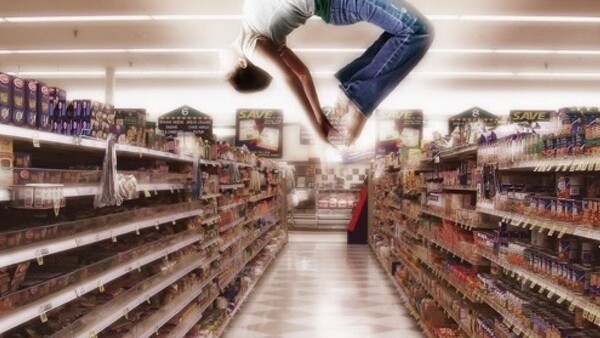
 Social media has not only revolutionized the way brands market their products but the way they sell it too. There’s been a lot of discussion recently about the rise of social commerce. We’ve seen brands keep trying to come up with alternatives or complimentary ways to reach their customers and make sales apart from enriching their traditional e-commerce platforms with social features. Let’s take a look at some of the solutions they’ve come up with for their e-shops.
Social media has not only revolutionized the way brands market their products but the way they sell it too. There’s been a lot of discussion recently about the rise of social commerce. We’ve seen brands keep trying to come up with alternatives or complimentary ways to reach their customers and make sales apart from enriching their traditional e-commerce platforms with social features. Let’s take a look at some of the solutions they’ve come up with for their e-shops.
Tumblr: Microblogging platform Tumblr has been warmly embraced by brands, mostly in the fashion industry. “Over the past year, fashion has emerged as one of the fastest growing segments of the Tumblr community, with 20% of our top 1,000 blogs related to fashion,” said Rich Tong, Tumblr’s new fashion director.
Apart from its use for blogging by fashionistas like Erica Domesek’s P.S.-I made this and Tricia Gosingtian’s Tricia Will Go Places, it has been used by fashion sites like Lookbook.nu and DesignerSocial, magazines like Dazed and Confused, Vogue, Elle, Life and New Yorker, TV shows like Today Show and TV channels like Comedy Central.
Tumblr has also been used by brands for community building like IBM’s Smarter Planet, which is focused on global issues and is open to readers for submitting their suggestions for posts and asking questions to join in conversations and EMI’s Tumblr, which is basically a curation of music news, videos and some free downloads. Huggies with Highchair Critics has built a resource for parents, that goes beyond providing information for its products alone and fashion brands Edun with Eye of Edun and Nicole Miller with Nicole Miller NYC provide backstage material and lots of visual inspiration. A very interesting project was the All Day Every Day creative agency’s collaboration with MAC cosmetics & Milk Studios on Phone Tag a live photoblog for New York Fashion Week S/S 2011 for backstage material taken with mobile phones open to the FWNY attendees.
Standard Hotels comes close to using Tumblr as an e-commerce solution with Standard Culture, which provides cultural news, art photo galleries and free to download playlists and event listings as well as a shop tab that takes you to the Standard Hotels e-shop powered by Shopify, without the user realising they actually left Tumblr. A full use of Tumblr as an e-commerce platform for the first time is made by Of A Kind, which we wrote about on its launch date. The site carries exclusive, limited-edition items by emerging designers and supports their e-shop by connecting their Tumblr to Shopify. But unlike Standard Hotels you can conclude your shopping experience without ever leaving Tumblr. It looks like an e-commerce application powered by Tumblr can’t be that far into the future.
Facebook: As we’ve mentioned in previous post f-commerce is on the rise as more and more brands start to use it, not only as a marketing tool but as a sales point too. Some brands use Facebook for pop-up stores, promoting exclusive sales for their fans before items hit the stores. Other examples include special edition items designed only for their Facebook fans or full fledged f-shops like P&G did with Pampers Web Store in partnership with Amazon.
YouTube: Fashion films, such as live streaming from runway shows have rapidly become the latest fashion obsession while etailers like Zappos use product videos to enrich their shopping experience. Westfield London mixed video and shopping with their interactive “click to buy” videos showing A/W 2010 trends from fashion shows powered by Link To but they didn’t put much effort into achieving that through platforms like YouTube and Vimeo. This is why the following case study stands out: YouTique by French Connection (UK). This ‘YouTube boutique’ showcases the brand’s items through original videos offering styling advice as well as videos from its runway shows. YouTique uses YouTube’s e-commerce solution; if one clicks on the video to buy an item, a new window opens leading to the item’s page on French Connection’s site. Video shopping may still have a “rough” feel, especially for the high demands of the fashion world, but with TV going through a transformation period itself (GoogleTV, AppleTV ) it looks like the video will play a big part in shaping the future of e-commerce.
Boutiques: Although fresh in the game, Boutiques.com by Google has already made a huge impression in the fashion world despite its certain flaws. For example, Google’s Boutiques hosts shops by retailers like ModCloth and designers like Christian Siriano and when someone clicks to buy a certain item, a new window opens leading to the e-commerce site linked to the item.
Online Publications: Platforms like Issuu and Zinio have made online publications “shoppable” by giving the publishers the option to add links to their publications. This way magazine publishers have linked their ads and the products they feature straight to their clients e-commerce sites, like Lonny magazine has done. Retailers have made “click and buy” catalogues like LaRedoute has done with it’s Issuu catalogues. Although online publication platforms, so far, do not provide a full e-commerce solution for brands, they still can add value to the overall shopping experience and an extra selling point.
Polyvore: Another social site offering fashion brands and retailers like Bergdof Goodman the opportunity to reach their customers and make a sale in a more social way.
Custom made social platforms: Apart from enriching their existing e-shopping sites with social features and using existing platforms to sell their products, many retailers have been experimenting with creating new social e-commerce platforms like Asos Marketplace and the soon-to-come Le Lab by Brand Alley.
With the social e-commerce fever rising faster even than the Bieber fever looks like the term “looking for a product” will soon be an expression of the past as products will soon be looking for us, on any platform we may be. Which case studies stand out for you?
Get the TNW newsletter
Get the most important tech news in your inbox each week.





